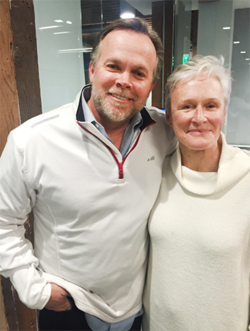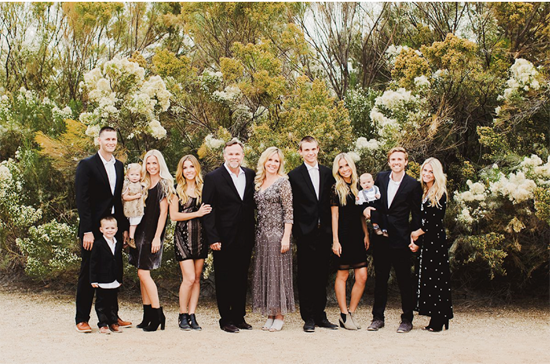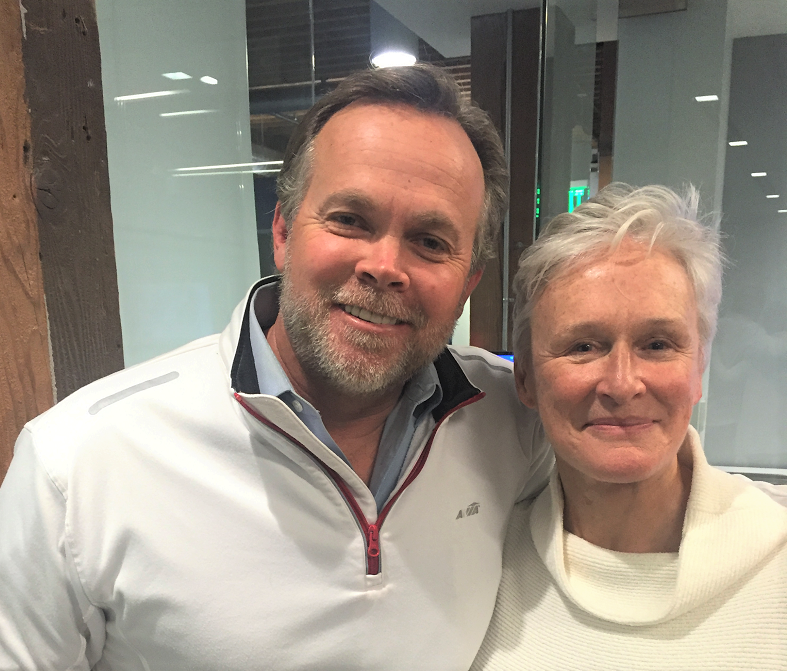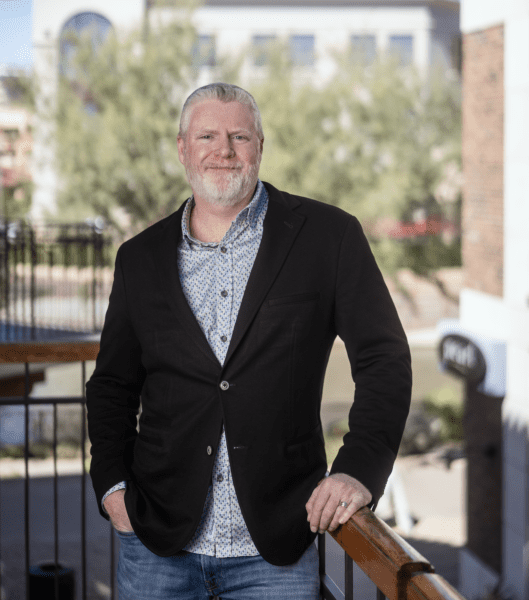Rose Law Group Reporter
In this week’s continuing Q&A series we spoke with Stacy Brimhall, founding partner of Langley Properties, via email.
You really are a visionary when it comes to Arizona land and development. We know you hate talking about yourself but can you just tell us over the years how many acres you have controlled?
Over 50,000 with investors.
You have said that your mind just works a little differently which has helped you become so incredibly successful in Arizona real estate. Tell us what you mean about your “mind working differently” when it comes to thinking about real estate?
My mind has always been attracted to squares, fortunately for me, land is in squares. I bought my first piece of ground when I was 12 years old after selling off a couple of calves I had raised.

You have agreed to talk to us about a very personal topic, your own battle with depression. We thank you for this and think it will do a real service to our readers as we know everyone has someone in their lives who fights this battle. You have published what is really a great and impactful book, “Defeating Depression – One Man’s Fight to Find Joy”.
We read this and are passing it along to others who fight depression and those who love them. We are 100 percent sure it will help people who suffer. We would also note that you are not taking any of the proceeds from the book but rather you are donating them all to the charitable organization, Bringing Change 2 Mind. How did you decide to write this book… and we can’t help but ask, how did you get hooked up with the great actress Glenn Close who wrote a well deserving complimentary Foreword to the book?
Bring Change to Mind (BC2M) was founded by David Watson, a most remarkable man, and businessman and by Glenn Close a most remarkable actress. David’s daughter Emily had taken her life after many years of struggling with depression. Both Glenn’s sister and nephew have struggled horrifically with schizophrenia. What Glenn and David both witnessed through these horrible events is that people were afraid to talk about it. This is what inspired them to start BC2M and what inspired me to write my story. Hopefully, my story not only gives the reader understanding of the illness but also a willingness to talk about it and get help. There should be no more shame in talking about it than you would an illness from the neck down.
When did you first know you suffered from depression?
It started in 1990 and we had no idea what was going on, we didn’t even know what depression was. Eventually, I was hospitalized for 2 weeks and the diagnosis was made. I write in the book of how devastating this was to me at first.
Tell us about what you are calling the Barbed Wire Principle and how do you use it in your daily life?
There are four principals to the barbed wire principal that I call “fight:”
-
“I will not give up, I will not be beat.”
-
“Forgive them, they know not what they do” (those that ostracize or make fun of you).
-
“Forget them” (still care about them but stop caring what they think of you).
-
“Wink & then laugh” (wink-all is going to be okay; laugh-laugh in the face of danger… “I won’t give up, I won’t be beat.”)
One day a friend of mine was checking a fence line. This is a process of riding your horse along the barbed wire fence.
Obviously, it’s an important job so your cows won’t wander off. While mending a part of the fence, he had a heart attack and fell to the ground. The pain was so excruciating that he just wanted to lay there and die. But, Mr. Leonard had “Fight.” He realized that the grass he was laying in was so high, that if anyone did drive by on this remote road, they would never see him.
So, he had a choice. Lay there and die or prop himself up somehow to where he could be seen if a car came by (and thus, demonstrate a willingness to get help). Slowly, he started to make his way to the barbed wire fence. It was excruciatingly painful. He finally got his hands on the bottom wire and after about 30 minutes, he climbed his way to the fifth wire at the top.
He held on to the top wire, but realized he couldn’t hold on for long and would soon drop back down to the ground. So, he slowly turned his back to the barbed wire fence. Somehow, he was able to stay erect, and then he wrapped one arm in the wire and then the other arm in the wire as well. His legs then finally gave out on him, and he hung there in the wire in the crucifix position until someone came along and unwrapped him from the fence and got him to the hospital. Mr. Leonard lived.
When I am suffering, I imagine myself climbing the wire. When I finally get to the top, I turn my back to the top wire, wrapping both arms in it, repeating to myself the four mind ingredients of “Fight.” Sometimes, my head is down, unable to lift it; yet, I continue repeating the ingredients. Eventually-every time-I finally get the strength to lift my head, give a little smile and wink. Using what I now call The Barbed Wire Principle in this way-and applying the ingredients of “Fight” with tenacity, faith and a willingness to get help-eventually, I am able to unwrap my arms and stand on my own feet.
What would you tell someone who interacts or cares about someone who suffers from depression – how can they be helpful to the fighter and how can they be (inadvertently) unhelpful?
Treat their illness like you would an illness from the neck down. Instead of saying what is wrong with you, ask them to explain to you how it feels. Don’t tell them to square their shoulders and cowboy up, this would be like asking a person with 2 broken legs to carry a barge up Mt. Everest. Help them get professional help, medication and practice with them the elements of fight found in the barbed wire principle.
You talk about four principles of fight – the book is great at outlining these and everyone can use them in their daily lives. We don’t want to spoil the full read but can you tell us about “wink and smile”?
A little more on wink and then smile. Unknown to us kids, my mother suffered from severe depression. I felt this untreated depression lead her to get cancer. One Sunday afternoon, I heard a crash in her bedroom. When I opened the door, my dad was helping her up but she was uncontrollably shaking. The shaking had caused her to fall. As she saw me she smiled a feeble smile but then winked.
It’s not just the shaking that I remember. Even though I have come to understand exactly how that uncontrollable shaking feels, that’s not the part of the memory of mom that is most clear. It’s the wink that indelibly etched itself upon my mind. That wink forms an ever-changing picture of varied meanings, all of which have been monumental to my journey for joy through this awful hell. It’s a picture that has spoken far more than a thousand words, a picture that continues to speak.
At the moment it happened, the wink spoke to me, saying, “Don’t worry, son; I’ll be okay. You run along now.” The wink is probably the only thing that got me to shut the door and walk away. As the years continue to pass from one to the next, the wink has continued to speak to me.
When my mother had died, and right before they lowered her into her grave, my dad opened the casket and placed a rose on her body and kissed her forehead. I don’t know why, for obvious reasons it did not physically occur, but I felt my mom wink at me. It was a feeling that transcended time, that ignored surroundings, and that reached across the chasm of death and again spoke the message to me, “Don’t worry, son; I will be okay. Shut the casket, run along now. Taste, hear, feel, love, smell, look, but more importantly see the glorious earth and all it has to offer. Live, Stacy. Live for me… and laugh.”

What would you tell those who are, as you say, “fighting to find joy”?
I would suggest to those that are suffering that there is help, that you can live productive, joyful lives. You can be a parent and a good one. This illness may knock you down, get back up. Keep trying, keep working, if you can’t get out of bed, crawl. Never, ever, ever give up.
There are those in our industry who have been great mentors and have helped me significantly in my battle with depression: Jordan and Jason Rose, Tim O’Neil, John Graham, Dan Baldwin, Nate Nathan, Ted Northrop, Conley Wolfswinkle, Carson Brown, Ken Reycraft, Mike Ingram, Chris Crogan, Steve Rees, Joshua Brimhall, Josh Bagley, Lothaire Bluth, Mike Delgado, Ed Hendricks, Ron McRae, Dale Huish, George Dover, Ethan Willis, Dave & Ty Lesuer, Ronnie Price, Andy Skipper, Michael Martindale, my dad, Elder Willis, Broc Hiatt, Jesse Turley, Bigalow brothers, Crispin Baynes, Bob Yost, Monte Nevitt, Jim Ogema, Cameron Bawden, Clyde Bawden, Dave Lords, Christine Jones, Bob Worsley, Brian Hanger, Jack Doughty, Michael Markakis, Paul Gardner, Susan Brown, Mike Dalton, Tim Wolff, Jay Petkunis, David Rouseu, Rob & Mark Ward, Dan Wardrop, David Van Slyke, Jim Zaheris, TJ Zaheris, LeRoy Breinholt, Johan DeKeizer, Bill Andrews, Steve Sossaman, Harold Christ, Andrew Martin, Denny & Jason Barney, Mike Goodman, Tyler Robison, Kenny & Brian Frakes, Seth Keeler, Sandie Smith, Bill Lund, Justin Merritt, Patrick Cardon, Larry Miller, Brian Lee, Will French, Sean Walters, Mark Bramlett, Terry McDonald, etc, etc, etc and most of all my family: Parshelle, Joshua, Alyssa, Baylee, Riley and Cole.
If you are silently suffering get professional help & reach out to me or any true friends like the ones I have listed. Thank you to all those who help me deal with this illness. You are loved and appreciated.
~Stacy












